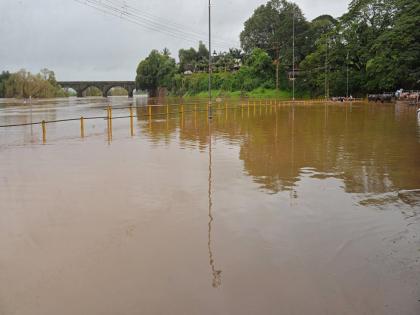Maharashtra Rains: Panchganga River Overflows as Kolhapur Receives Continuous Downpour
By Lokmat English Desk | Updated: July 4, 2025 13:22 IST2025-07-04T13:21:00+5:302025-07-04T13:22:34+5:30
Kolhapur and its nearby regions witnessed alternating spells of sunshine and heavy rain. Intense downpours in the morning were ...

Maharashtra Rains: Panchganga River Overflows as Kolhapur Receives Continuous Downpour
Kolhapur and its nearby regions witnessed alternating spells of sunshine and heavy rain. Intense downpours in the morning were followed by brief sunny weather around 2:30 PM on July 3. However, due to continued rainfall across the dam catchment areas, the Panchganga River overflowed its banks once again. Water levels across all rivers and reservoirs have risen significantly, approaching warning levels. As a result, around 50 weirs in the district have been submerged, and traffic has been diverted to alternate routes. The district has been experiencing consistent and heavy rainfall for the past two days.
Continuous rainfall in Tal Konkan and the dam catchment regions has led to multiple reservoirs in Kolhapur district reaching near full capacity. Dams such as Jungmahatthi, Ghataprabha, and Jambare in Chandgad, Ambeohol and Sarfnala in Ajara, and Yenechvandi in Gadhinglaj have completely filled. The Dhamani dam has reached 90% capacity, while all major, medium, and minor dams in the area have filled to at least 50%. The Koyna Dam now holds 58.81 TMC of water, with inflows of 33,286 cusecs and an outflow of 1,050 cusecs, indicating the increasing pressure on the water infrastructure.
Similarly, the Almatti Dam has recorded a storage level of 88.120 TMC, receiving 93,963 cusecs of inflow and releasing 1 lakh cusecs of water. Authorities expect water discharge to begin from the Dhamani dam spillway by Thursday night or Friday, which could lead to a further rise in the Dhamani riverbed's water level. The irrigation department has issued an advisory urging residents near the riverbanks to remain vigilant. It has also asked tourists to avoid visiting the dam sites until conditions stabilize, as the situation remains sensitive due to the increasing water levels and continued rainfall.
In the Warna Dam region, extremely heavy rainfall has pushed the dam’s water level to its spillway mark. To maintain safe levels, authorities will release up to 4,500 cusecs of water into the Warna River over the next 24 hours — 2,840 cusecs through the dam's curved gates and 1,660 cusecs to the power plant. This was confirmed in a press release by B.R. Patil, Sub-Divisional Engineer of the Warna Irrigation Subdivision. As precautionary measures continue, residents downstream have been advised to take safety measures and avoid unnecessary travel near riverbeds or low-lying zones.
Meanwhile, the Panchganga River's water level also showed a marked rise. At 4 AM on Thursday, the water level at the Rajaram Weir stood at 31.4 inches. By 5 PM, it had reached 31.11 inches. The warning level for the river is marked at 39 feet, and current trends suggest water levels are steadily heading in that direction. This ongoing surge highlights the urgency of the situation, as officials continue to monitor inflows and potential flood risks. Citizens in low-lying areas are being kept informed and advised to stay alert through district administration channels and weather updates.
Open in app